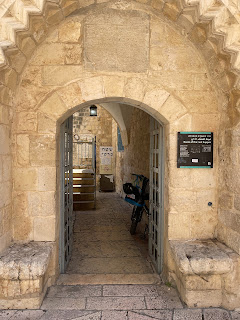The Upper Room
T
oday, on Tuesday of Holy Week, the gospel leads us to visit the Upper Room in Jerusalem. I was blessed to visit Jerusalem from July to August of last year, two months before the Israel-Hamas war broke out. If I were to rank the holy sites according to memories of Jesus and his disciples, this room would be at the top of my list. It is a repository of precious memories that, if only the walls could speak, would recount all the moments that shaped the course of human history, beginning from the lives of those who first gathered there. The Upper Room is traditionally called “cenacle” (from the Latin cenaculum, "dining room").
It is administered by the Israeli authorities and is part of a building holding the so-called "David's Tomb" on its ground floor. God chose this Upper Room to be the setting for the last meal that, in the Gospel accounts, Jesus held with the apostles and the first Eucharistic meal that every mass would commemorate in the next two thousand years. As we step into this sacred space, let us first reflect on its physicality.
The Upper Room was not grand. Rather, it was a very simple chamber, like a small multi-purpose hall that was empty and humble in appearance. I have visited this room twice. The first time as a tourist, where I took pictures here and there. However, I was given another chance on another day to go back to the Cenacle, but this time to pray. When I went there in this second instance, something extraordinary unfolded inside the unassuming confines. Indeed, when you take a pause to be silent, it is a powerful way of connecting with the sacredness of any place on earth. Prayer can bring back to life the gospel accounts. At the Cenacle, Jesus shared his last supper with his beloved disciples before his crucifixion—a meal that would become the foundation of the Eucharist, a sacrament of unity and remembrance for Christians worldwide. It was a place of intimate communion, where Jesus imparted profound teachings to his disciples, namely the breaking of the bread and humble washing of the feet by Jesus. We must not forget that the Cenacle was the place of betrayals. Not just by Judas. The gospel of John singles out and identifies by name the apostle who would betray Jesus. If I were Judas, I would say it is unfair; Peter also betrayed the Lord, and so did the rest of the group. All twelve ran away when Jesus needed them the most, yes, even John who was called the beloved ran away. And this is where the image of the Lord stands out. He knew then that he would be betrayed yet he still chose to celebrate with great tenderness a meal. Such intimacy, having the full knowledge that he would soon lay down his life for his friends.
Let us not think the story of the Cenacle ended in the physical room in Jerusalem. No. The room is multiplied all over the world and remembered most dearly during Holy Week. This chamber where we are now gathered is a Cenacle, and it is filled with apostles like you and me. Even if we have betrayed the Lord so many times, we have always been welcomed in this Cenacle year in and year out. After each celebration of the Eucharistic meal, we always come out of this chamber, this Cenacle, nourished by being more forgiven and by being ever more loved. Amen. Fr JM Manzano SJ



Comments
Post a Comment
Thank you for your interest in the above post. When you make a comment, I would personally read it first before it gets published with my response.